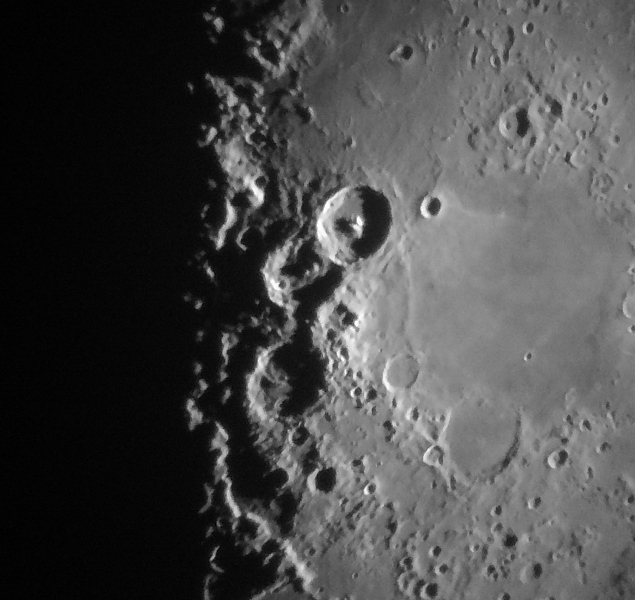Mt Lemmon Observatory from Oracle,
iPhone Moon Craters
Posted: 24 May 2015
Wednesday, 20 May 2015, dawned with high thin clouds still in the sky. Clouds continued during the day on Thursday, 21 May, but the night was clear. However, I didn't open the observatory that night as the Oracle Dark Skies Committee was invited to Mt Lemmon Observatory for a special visit in recognition of its efforts in preserving southern Arizona dark skies. A report with photos is available. Friday, 22 May, began with clear skies but clouds began appearing mid-day along with strong winds. Saturday was mostly clear until late afternoon when some clouds appeared. Decided to try some observing.
|
Open: Saturday, 23 May 2015, 1803 MST Temperature: 84°F |
Session: 823 Conditions: Party cloudy, breezy |
Having seen Oracle and the location of Cassiopeia Observatory during my visit to Mt Lemmon Observatory I decided to check if I could see the observatory domes from Cassiopeia Observatory. I could not see them from the observatory due to some trees. However, I found a location just outside our house to the east of my observatory where I could see them 11 miles away and about 5000' higher in elevation.
Oracle from Mt Lemmon Observatory:

Mt Lemmon Observatory from Oracle:


I can also see Kitt Peak National Observatory (65 miles away), as seen here in December 2009:

It is nice to have these big brothers looking over Cassiopeia Observatory!
There were a lot of clouds in the sky as sunset approached:

1822 MST: viewed Venus, 83X, through some thin clouds. 1824 MST: Jupiter was faintly visible at 83X one hour before sunset. Then viewed the Moon, 83X. This handheld iPhone 5s afocal 83X photo was taken at 1827 MST through some thin clouds:

By 1842 MST the Moon was obscured by the clouds. 1852 MST: the Moon was now in the clear again. Switched to the William Optics Binoviewers and viewed the Moon at 100X. The view was nice with good 3D effect, particularly on the northern portion of the Moon.
1917 MST: western half of sky was now clear. Viewed Venus, then Jupiter, Binoviewers 100X. Three of the Galilean Moons were visible at 1920 MST. Then a minute later, the fourth (Callisto) became visible. 1924 MST: sunset. Added the 1.6X Barlow Lens and viewed Jupiter at 160X. Seeing was not good but the view was nice using both eyes.
1946 MST: did some lunar observing, Binoviewers 160X. The view was pretty good, especially the craters Posidonius and the crater chain of Theophilus, Cyrillus, and Catharina. These cropped handheld iPhone 5s afocal 160X photos show the views:
Crater Posidonius:

Craters Theophilus, Cyrillus, and Catharina:

1957 MST: the central peaks in the crater Theophilus showed lots of details at 160X through the Binoviewers during brief moments of good seeing. Unfortunately, the seeing was noticeably deteriorating.
2003 MST: the western sky, D7200 DSLR, f/4.5, 1/30sec, ISO 1250, FL 18mm:

Mouseover or tap on image for labels
2009 MST: final look at the Moon, 83X. Then began closing up.
|
Close: Saturday, 23 May 2015, 2019 MST Temperature: 62°F |
|
Comments are welcome using Email. If you are on Twitter you can use the button below to tweet this report to your followers. Thanks.
Cassiopeia Observatory Home Page
Copyright ©2015 Michael L. Weasner / mweasner@me.com
URL = http://www.weasner.com/co/Reports/2015/05/24/index.html
